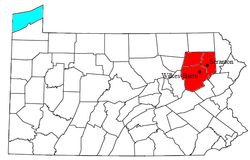Scranton-Wilkes-Barre Metropolitan Area
| Wyoming Valley, PA MSA Metropolitan Statistical Area |
||||||
|---|---|---|---|---|---|---|
| Scranton/Wilkes-Barre/Hazleton | ||||||
|
||||||
 Location of the Scranton–Wilkes-Barre–Hazleton Metro Area within the State of Pennsylvania. |
||||||
| Coordinates: 41°18′N 75°54′W / 41.3°N 75.9°W | ||||||
| Country | United States | |||||
| State(s) | Pennsylvania | |||||
| Largest city | Scranton | |||||
| Other cities | - Wilkes-Barre - Hazleton - Pittston City (Greater Pittston) - Nanticoke |
|||||
| Area | ||||||
| • Total | 1,776 sq mi (4,600 km2) | |||||
| Highest elevation | 2,460 ft (750 m) | |||||
| Lowest elevation | 400 ft (100 m) | |||||
| Population | ||||||
| • Total | 558,166 | |||||
| • Rank | 97th in the U.S. | |||||
The Wyoming Valley is a historic industrialized region of Northeastern Pennsylvania once famous for fueling the industrial revolution in the United States with its many anthracite coal mines. As a metropolitan area, it is known as the Scranton/Wilkes-Barre metropolitan area, after its principal cities, Scranton and Wilkes-Barre, and is the 97th-largest metropolitan area in the United States and the 4th largest in Pennsylvania. It makes up its own unique physiographic province, the Anthracite Valley in the geology of Pennsylvania. Greater Pittston makes up the center of the valley. Scranton is the most populated city in the metropolitan area with a population of 77,114. The city of Scranton has grown in population after the 2015 mid term census while Wilkes-Barre has declined in population. Wilkes-Barre is still the second most populated city in the metropolitan area and Hazleton is third. The airports for this area are Wilkes-Barre/Scranton International Airport (Avoca) and the Wilkes-Barre Wyoming Valley Airport (Forty Fort).
The valley is a crescent-shaped depression, a part of the ridge-and-valley or folded Appalachians. The Susquehanna River occupies the southern part of the valley, which is notable for its deposits of anthracite. These have been extensively mined. Deep mining of anthracite has declined throughout the greater Coal Region, however, due to the greater economics of strip mining. Parts of the local mines had already shut down because some coal beds were on fire and had to be sealed; but the exodus of mining companies came quickly following the legal and political repercussions of the 1959 Knox Mine Disaster—when the roof of the Knox Coal Company's mine under the river collapsed. The Pocono Mountains, a ridgeline away, are often visible from higher elevations to the east and to the southeast of the Wyoming Valley.
...
Wikipedia




